
Iris bucharica is a species of flowering plant in the family Iridaceae. It is a bulbous herbaceous perennial, from temperate Asia, within Afghanistan, Tajikistan and Uzbekistan. It has long blue green leaves, many flowers in spring, in shades of yellow and white.
Iris pamphylica is a plant species in the genus Iris. It is the largest member of the subgenus Hermodactyloides, it is also in the section Reticulatae. It is a bulbous perennial from Antalya Province in Turkey, Asia. It has long narrow leaves, shorter stem holding a bi-coloured flower in shades of purple, blue or purple-brown, with a yellow, purple-spotted section on a petal.
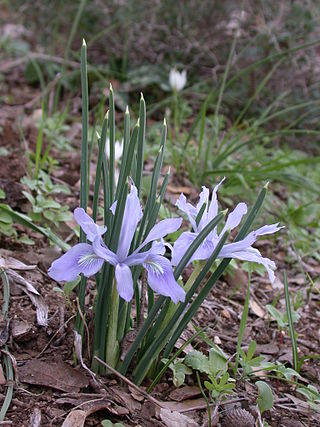
Iris vartanii is a plant species in the genus Iris. It is classified in the subgenus Hermodactyloides and section Reticulatae. It is a bulbous perennial.

Iris histrio, the Syrian iris, is a species in the genus Iris, it is classified in the subgenus Hermodactyloides and section Reticulatae. It is a bulbous perennial from Central Asia: Kyrgyzstan, Israel, Lebanon, Syria and southern Turkey.

Iris filifolia is a species in the genus Iris, it is also in the subgenus Xiphium. It is a bulbous perennial from North Africa and Europe. It has thin leaves, summer flowers in shades of red-purple.
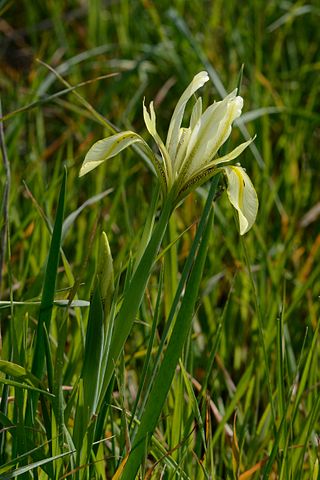
Iris ser. Syriacae is a series of the genus Iris, in Iris subg. Limniris.

Iris grant-duffii is a species in the genus Iris. It is also in the subgenus Limniris and in the series Syriacae. It is a rhizomatous perennial, from Lebanon, Israel, Syria, Turkey, Lebanon and Iraq, which has brown bristles/spines on the rhizome, long thin greyish green leaves, short stem carrying a single scented flower in shades of yellow.
Iris farreri is a beardless iris in the genus Iris, in the subgenus Limniris and in the series Tenuifoliae of the genus. It is a rhizomatous herbaceous perennial, from China. It has grey-green leaves, long stem and 1 or 2 violet, lilac or light blue flowers. It has undergone several changes of name and series, before being left as Iris farreri.

Iris korolkowii is a plant species in the genus Iris, it is also in the subgenus Iris and in the section Regelia. It is a rhizomatous perennial, from the mountains of Tien Shan, Pamir and Altai, in Afghanistan and Turkestan. It is commonly known as the Redvein Iris. It has long, sword-shaped grey-green leaves, slender stem, and 2 to 3 white, cream, pale green or light purple flowers which are veined with maroon, chocolate brown or dark purple. It is cultivated as an ornamental plant in temperate regions.
Iris benacensis is a plant species in the genus Iris, it is also in the subgenus Iris. It is a rhizomatous perennial, from Italy. It has similar sized leaves and stem, and blue-purple shaded flowers, that have a white, blue and yellow beard. It was once classified as a synonym of Iris aphylla, before being re-classified as a species in its own right, although some sources still call it a synonym. It is cultivated as an ornamental plant in temperate regions.
Iris cypriana is a plant species in the genus Iris, it is also in the subgenus Iris. It is a rhizomatous perennial, from Cyprus. It has narrow, glaucous and evergreen leaves, tall slender stem, with 2–3 branches, and 1–3 large flowers in lavender, lilac, red-lilac, to dark purple shades. It is cultivated as an ornamental plant in temperate regions. It is listed in some sources as a synonym of Iris germanica.
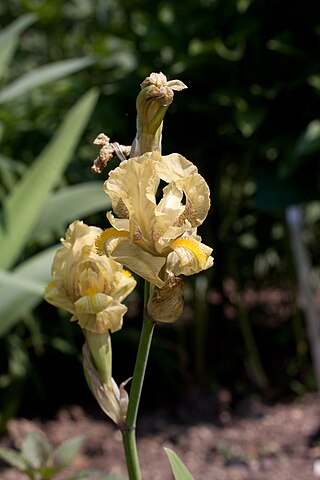
Iris imbricata is a species in the genus Iris, it is also in the subgenus Iris. It is a rhizomatous perennial, from the Caucasus mountains, within Iran, Armenia, Azerbaijan and Georgia. It has broad, sword-like, yellow green or light green leaves, slender stem with branches, inflated and overlapping green spathes, and 2–5 yellow, pale yellow or greenish yellow flowers.
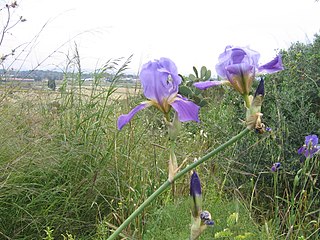
Iris mesopotamica, the Mesopotamian iris, is a species in the genus Iris, it is also in the subgenus Iris. It is a rhizomatous perennial, from the middle East, within the countries of Iraq, Turkey, Syria and Israel. It has linear, grey-green or green broad leaves, tall stem with 2–3 branches, holding up to 9 scented flowers, in shades of violet, purple, lavender blue and light blue, with a yellow and white or orange and white beard. It is listed as a synonym of Iris germanica in some sources. It is cultivated as an ornamental plant in temperate regions, including being planted in graveyards and cemeteries but may also be used for celebrations and decoration.
Iris schachtii is a plant species in the genus Iris, it is also in the subgenus Iris. It is a rhizomatous perennial, from central Anatolia, in Turkey. It has small, thin grey-green leaves, a short stem with 1–3 branches, which are normally, covered with a green leaf with purple staining. It has 2 or more fragrant flowers in late spring, which come in shades of yellow or purple, or violet and yellow,. It has a yellow or white with yellow-tips beard. It is cultivated as an ornamental plant in temperate regions, but prefers regions with dry, hot summers.
Iris taochia is a plant species in the genus Iris, it is also in the subgenus Iris. It is a rhizomatous perennial, from the Caucasus mountains and Turkey. It forms dense clumps, with grey-green leaves, simple stems of similar height, with 1–3 branches, a flowers in various shades from white, yellow to purple. They also have yellowish or white, tipped yellow beard. It is cultivated as an ornamental plant in temperate regions.

Iris acutiloba is a species in the genus Iris, it is also in the subgenus of Iris and section Oncocyclus. It is a rhizomatous perennial, from the mountains of the Caucasus and found in Turkey, Armenia, Azerbaijan, Turkmenistan, Dagestan in the North Caucasus, and Iran. It is a dwarf species, with narrow, falcate or curved leaves, it has one flower in spring or early summer, that comes in shades from cream, creamy white, whitish, pale brown, light grey, to pale violet. It is heavily veined or streaked and pointed, with 2 dark spots and brown, purple, dark purple, or black short beard. It is cultivated as an ornamental plant in temperate regions. There are two subspecies, Iris acutiloba subsp. lineolata and Iris acutiloba subsp. longitepala.

Iris atropurpurea, the coastal iris is a species in the genus Iris, it is also in the subgenus of Iris and in the section Oncocyclus. It is a rhizomatous perennial, from the Middle East. It has glaucous (blue-green), linear, falcate (sickle-shaped) leaves. Between February and March, it has between 1 and 2 flowers, in dark shades from red-brown, burgundy, dark purple to blackish purple. They have a darker signal patch and yellow beard tipped with purple. It is rarely cultivated as an ornamental plant in temperate regions, due to it needing very dry conditions.
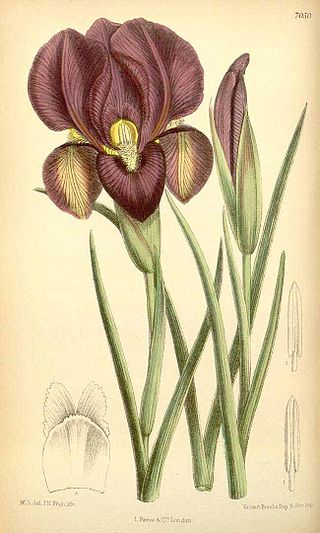
Iris barnumiae is a species in the genus Iris; it is also in the subgenus Iris and in the section Oncocyclus. It is a rhizomatous perennial, from Armenia, Azerbaijan, Iran, Iraq, and Turkey. It has pale glaucous green and narrow leaves, that are slightly sickle-shaped and fade soon after blooming. It has, in mid- to late spring, fragrant flowers in shades of purple, from red-purple, mulberry to purplish-violet, with a yellow tipped with purple beard. It was renamed as I. barnumiae in after a plant naming conference in 2011, but is still sometimes named as I. barnumae in some sources. It has one accepted subspecies Iris barnumiae subsp. demawendica and two forms; Iris barnumiae f. protonyma (Stapf) B.Mathew & Wendelbo and Iris barnumiae f. urmiensis (Hoog) B.Mathew & Wendelbo, which has yellow flowers. Sometimes I. barnumiae f. barnumiae is used to describe the basic form. It is rarely cultivated as an ornamental plant in temperate regions, due to its needing very dry and warm summer conditions.

Iris gatesii is a species in the genus Iris, it is also in the subgenus Iris and in the section Oncocyclus. It is a rhizomatous perennial, from the mountains of Turkey and Iraq. It has long, narrow, grey-green or glaucous leaves. The strong, sturdy stem supports a single large flower in spring, between April and June. The large flowers are very variable in colouring, ranging from a pale greenish, grey, white, or creamy-yellow background colour, which is then covered with many purplish-brown, purple, or nearly black, spots, dots, short broken lines, or veining. They have a brownish purple or purple beard, over a dark signal patch. It can be cultivated as an ornamental plant in temperate regions, if it does not get too wet during summer.

Iris sari is a species in the genus Iris, it is also in the subgenus Iris and in section Oncocyclus. It is from the rocky steppes and hills of Turkey. It has curved or straight leaves, cream, greenish or yellowish flowers which are variable and veined with crimson, purple-brown, reddish brown, reddish-purple or black. It has a dark maroon, rich crimson or brown signal patch and gold or yellow beard.














